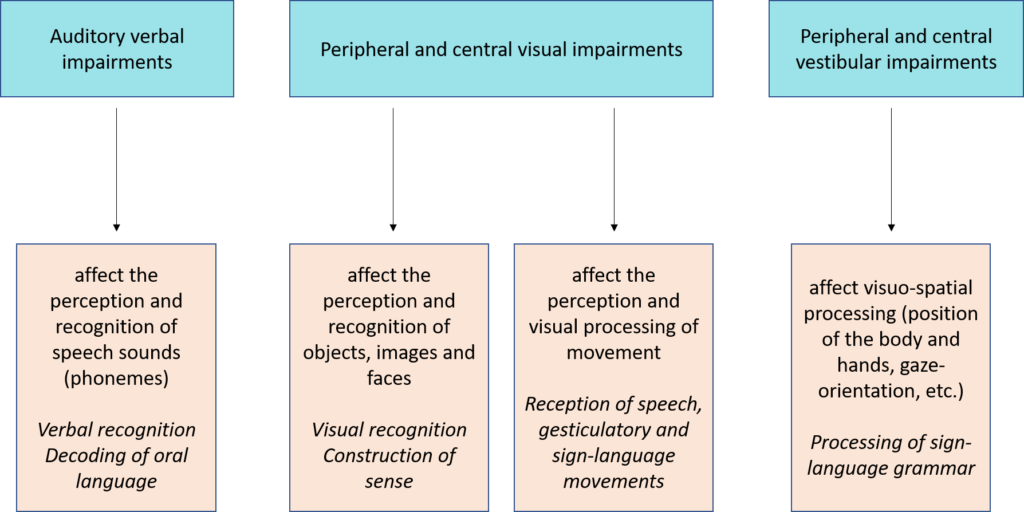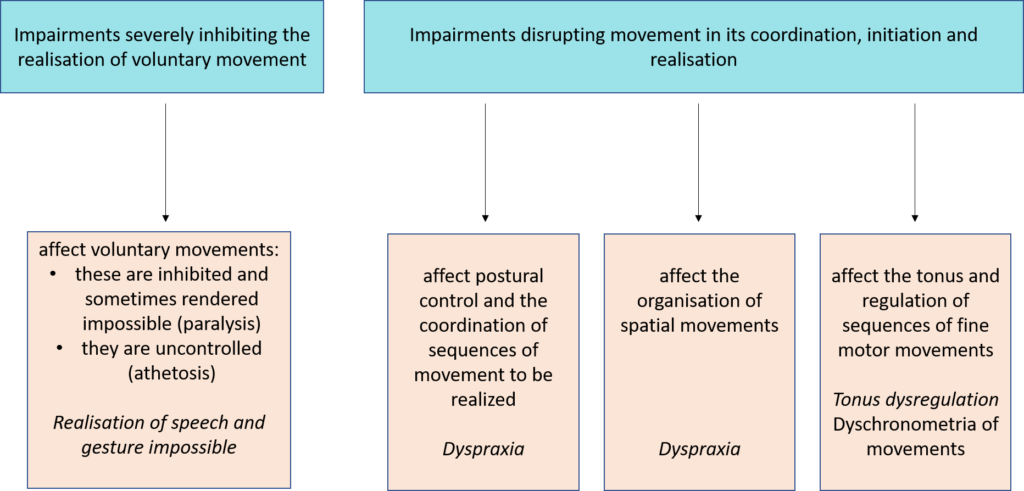Children presenting impairments associated with their deafness
More often than not, professionals in the field of hearing impairment call upon the Centre national de ressources Robert Laplane for deaf children presenting complex language disorders or learning difficulties not explained by their deafness alone. Their overall development is complicated by damage to their sensorial, cognitive or motor functions. We are also solicited on behalf of deaf children whose disability presents particularly complex challenges within an establishment not specialised in deafness.
The deaf or hearing people for whom we intervene have the common trait of significant communication difficulties. They can thus find themselves isolated, excluded, and in significant physical pain, due to the lack of training among the people around them, and to the lack of places appropriate to their disability within institutions for adults.
Our responsibility regarding these people is to better understand their needs in order to help the professionals around them in their search for a way forward and for appropriate solutions.
IMPAIRMENTS ASSOCIATED TO DEAFNESS
Hearing impairments are high in frequency: roughly one case of congenital deafness per 1,000 births, and the same proportion for acquired causes. They can take on a very wide range of clinical aspects and can arise at any point in a person’s life. The difficulties are not the same if the deafness occurs before, during, or after the ‘sensitive period’ of language acquisition. In the majority of cases, the deafness is isolated. Nonetheless, it can form part of a more complex pathological framework and thus be in combination with other impairments and/or various disorders.
Everyone is familiar with the role that hearing plays in language acquisition and child development. The earlier the damage to hearing, the greater the risk to the child in these areas, and the more a rapid intervention is required. The child learns to counterbalance their hearing loss through other channels: they bring other processing systems into play and find unique ways of communicating spontaneously. The occurrence of any other impairment associated with their deafness makes this task much more difficult. This is the case for roughly 20 to 25% of instances. These additional impairments are diverse: both in nature and in expression. Combined with deafness, their effects are potentiated and worsen synergistically.
Each combination of disabilities induces its own challenges. These challenges are likely to vary according to various factors which should always be taken into consideration:
- The age of first occurence of the various afflictions in relation to developmental stages, particularly regarding sensory afflictions, and, therein, deafness in particular
- The chronology of the appearance and establishment of these afflictions as they relate to each other
- The extent of the affliction, particularly the extent of hearing loss
- The likely course of the impairments and disorders over time
- The insidious nature of certain afflictions in the way they establish themselves
- The sometimes deceptive aspect of certain visible signs
A number of combinations may be encountered. Certain impairments conceal deafness while others are concealed by deafness. Problems surrounding diagnosis are always complex and are staggered over time.
Whatever the combination causing them, major difficulties in the child’s access to information are often the effect. The earlier these problems occur, the more they influence the child’s development and their way of life.
Consequently, combinations of impairments frustrate conventional intervention methods. Care and support become complicated and call for specialist skill sets.
The Centre de ressources Robert Laplane has elaborated a system to classify cases of rare disability over the course of its diagnostic and research roles regarding these impairments.
Roughly 1,500 cases were studied, this being a large enough sample group for the identification of cluster groups. We put this forward as a template for reflection on the different types of questions raised by diagnosis and treatment.
REGARDING THE EVOLUTION OF THE IMPAIRMENTS OVER TIME : 3 MAINS TYPES OF SITUATION
- Combinations unfolding early on, within the first few weeks
These are, for example, cases of deafness with evident visual impairment or, indeed, cases of deafness with severe motor impairment. In these instances, it’s the associated disorders which are in the foreground. They tend to conceal the presence of deafness, which needs to be searched for systematically, and is often only done so at a very late stage.
- Combinations potentially present at birth but which are only revealed over the course of development
This category concerns, in particular, disorders of a neurological origin affecting all major functions and instrumental and/or cognitive problems. This progressive materialisation is explained by the slow maturation of brain functions and by the often deceptive appearance of these disorders, which, moreover, tend to be concealed by deafness.
- Combinations occurring more lately
These are the result of progressive conditions or accidental traumas of some nature. Within the framework of progressive conditions, such as mitochondrial cytopathy, deafness can occur later on, and worsen in stages. It is the same case for many different disorders likely to occur. The disorders are established according to their own chronology. They evolve independently of each other, on their own account, and the disorders are not worsened simultaneously. As a result, the challenges of the disability are constantly changing.
AT THE FUNCTIONAL LEVEL : 2 MAINS TYPES OF ASSOCIATED IMPAIRMENT
- Impairments affecting sensory systems other than the auditory system
The repercussions of these impairments revolve mainly around access to information and worsen the effects of deafness. They affect the decoding of linguistic information and the construction of semantic networks (the construction of sense).

gf
- Impairments affecting effector systems and motricity
These concern the overall motricity of the body, as well as manual motricity, ocular motricity, and speech motricity. A number of systems may be affected simultaneously, which limits the person’s means of action and expression and reduces, in a more or less evident way, their ability to interact with their human and physical environment.

